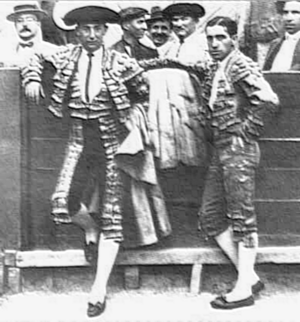Juan Belmonte facts for kids

Joselito and Belmonte
|
|
| Personal information | |
|---|---|
| Birth name | Juan Belmonte García |
| Nickname(s) | El Pasmo de Triana |
| Born | 14 April 1892 Seville, Andalusia, Spain |
| Died | 8 April 1962 (aged 69) Utrera, Andalusia, Spain |
| Sport | |
| Sport | Bullfighting |
| Position | Matador |
| Bullfighting career | |
| Début novillero | 21 July 1912 Sevilla, Andalusia, Spain |
Juan Belmonte García (born April 14, 1892 – died April 8, 1962) was a famous Spanish bullfighter. He changed the sport of bullfighting with his brave and unique style. Belmonte fought in a record number of bullfights during his career.
Contents
Juan Belmonte: A Bullfighting Legend
Early Life and Unique Style
Juan Belmonte was born in Seville, Spain. His family moved to the Triana neighborhood when he was three years old. He started his bullfighting journey in 1908. He toured Spain with a children's bullfighting group called Los Niños Sevillanos. Belmonte killed his first bull on July 24, 1910.
As an adult, Belmonte's bullfighting technique was very different. He stood almost still and very close to the bull. Other bullfighters usually kept a safe distance from the animal. Because of his daring style, Belmonte was often gored, meaning the bull's horns injured him. He received many serious wounds throughout his career.
One time, in November 1927, he was gored through his chest. This happened during a bullfight in Barcelona, Spain. Other bullfighters had to rescue him. The King and Queen of Spain were watching that day.
The Golden Age of Bullfighting
Belmonte had a famous rivalry with another great bullfighter, José Gómez Ortega. Ortega was also known as Joselito or Gallito. Their competition lasted from 1914 to 1920. This period is known as the Golden Age of Bullfighting.
Sadly, this era ended when Joselito was fatally gored on May 16, 1920. He was only 25 years old. After Joselito's death, Belmonte felt a lot of pressure. This led him to retire temporarily three times, starting in 1922.
Breaking Records
In 1919, Belmonte fought in 109 bullfights, called corridas. This was a record for any matador at that time. His record stood until 1965. That year, Manuel Benítez Pérez, known as "El Cordobés", performed in 111 corridas.
The Mexican matador Carlos Arruza fought 108 corridas in one season. It is said he chose not to break Belmonte's record out of respect.
Life After Bullfighting
After his third and final retirement in 1935, Belmonte moved to a large ranch. It was a 3,500-acre ranch in Andalusia, Spain. There, he lived like a gentleman who raised bulls.
He also published an autobiography in 1937. It was called Juan Belmonte, matador de toros: su vida y sus hazañas. This book shared his life story as he told it to the writer Manuel Chaves Nogales. The book was later translated into English.
Belmonte was good friends with famous authors. These included Henry de Montherlant and Ernest Hemingway. He even appears in two of Hemingway's books: Death in the Afternoon and The Sun Also Rises.
Legacy
Juan Belmonte truly changed the way bullfighting was done. He was born with slightly deformed legs. This meant he couldn't run or jump like other boys. So, when he became a matador, he stood firmly on the ground. He made the bull move around him, instead of him moving around the bull. Before him, many bullfighters moved around a lot, almost like circus performers.
He died on April 8, 1962, shortly before his 70th birthday. He is buried in the cemetery of Seville. His grave is close to that of his rival, Joselito. Belmonte's death caused great sadness in the city of Seville.
A film about his life, called Belmonte, was released in 1995.
Images for kids
See also
 In Spanish: Juan Belmonte para niños
In Spanish: Juan Belmonte para niños



